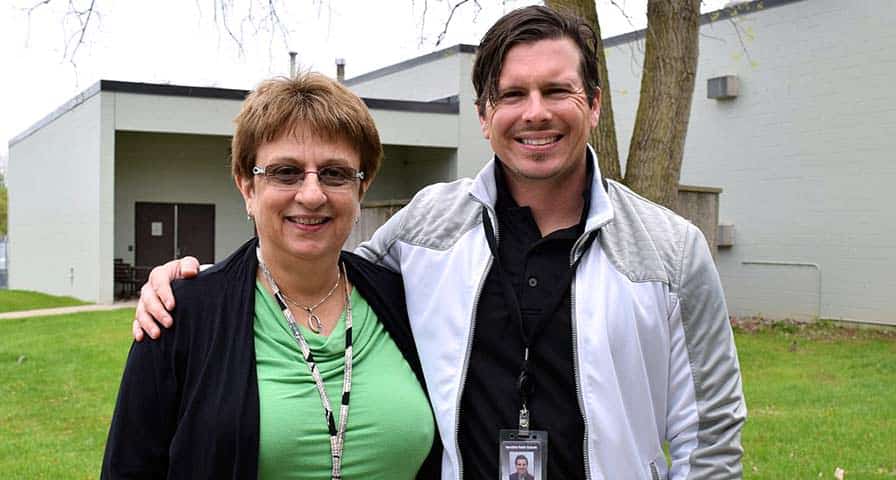A teacher’s unique use of heart rate monitors helped Ann Arbor, Mich., adapted physical education students learn to manage their health during the school day.
During a pilot program directed by Ann Arbor Public Schools Adaptive Physical Education Teacher Consultant Deak Swearingen, 30 students wore the IHT Zone heart rate monitors during their PE classes. While many students have health issues — some severe — and cognitive disabilities, Swearingen saw unexpected success with students learning to self-manage.
“I wasn’t sure the monitors would be able to teach [self-management] because I wasn’t sure that my students would have the cognitive ability to grasp it,” Swearingen said. “It’s something I’m extremely excited about.”
‘Understanding what the heart rate monitor showed’
Several times during the school year, Swearingen saw students benefit from a basic understanding of what the heart rate monitor showed them. The monitors, designed by IHT specifically for physical education, display a student’s heart rate by actual number and color – according to the level of exertion based on the student’s heart rate.
“I have a student who has behavior issues, and her issues can be quite severe,” Swearingen recalled. “This student has learned when she senses her anxiety begin to spike, she would actually ask me to go out on the track instead of being in the fitness center. With the technology, I’ve taken it to the next level with regard to safety.”
The student could see when her heart rate increased by the changing color on the wrist-based heart rate monitor. The monitor lights up blue if the student’s heart rate is normal, yellow as the heart rate climbs with moderate activity and red if the heart rate is in the vigorous zone. If the student noticed her monitor had turned yellow or red without her having exercised, she took it upon herself to maintain control of her behavior.
“She would walk a lap in order to cool down to self-regulate so she doesn’t have a meltdown and hurt anyone or herself,” Swearingen explained. “She made that connection. She doesn’t have the ability to understand 110 beats per minute, but if I program the monitor appropriately, she understands it going from red to yellow to blue and she can come back to class.”
‘Technology doing what I hoped it would’
Teachers and their assistants – often present in adapted learning environments – also benefitted from students wearing the wrist-based monitors. Swearingen said being able to see student heart rate served as a potential predictor to health or safety issues.
“I have a young man who is prone to having seizures,” Swearingen said. “He’s also cognitively impaired, so that makes it challenging for him to tell us when he feels like he might be having a seizure.”
All appeared well, but the student’s heart rate monitor quickly changed from blue to red while the student remained inactive.
“I had a strong idea that a seizure might occur for him,” Swearingen said. Because of what he saw, Swearingen made sure the student did not exercise during his PE session to minimize the likelihood of a seizure at school and also alerted the child’s family so they could be prepared if something happened at home.
“Later that night, he did end up having a seizure,” Swearingen said. “That was the first time where I really saw the technology doing exactly what I had hoped it would do.”
Expanding a pilot program
In creating the Spirit System technology, we sought to provide teachers with tools to further personalize learning for each student. That element prompted Swearingen to develop a pilot program for his students.
“It allows you really to individualize learning, individualize instruction, and that’s the focal point of adaptive PE,” he said.
By helping students develop at least a basic understanding about self-managing their health and well-being, Swearingen believes his program’s on the right path. He developed a curriculum specific to Ann Arbor’s adapted PE population that he can share with teachers at the system’s other 13 campuses. Swearingen hopes to use the Zone monitors on as many as 120 students in 2017-18, up from 30.
With training, Swearingen said teachers across the district with access to the district’s heart rate monitors can follow the protocols.
“I needed a platform where I can create a state and federally-mandated focused curriculum and then the teachers I coordinate and consult with have the ability to not recreate the wheel,” he said. “I’ve done all of the front-loading on what to teach, and I can work with [them] on how to teach it. Then it comes down to each teacher’s own individual approach as to how you use your teaching modalities to the best of your abilities.”
Connecting the educational team: teacher, student, parent
Swearingen trusts his teachers to make the most of the curriculum. He, along with the parents who receive emails from the Spirit System after each class session, can check progress and know exactly how each student did on a given day.
“The thing that is most crucial for me, I can’t be in 14 schools at once, but I can check the system and see how each student did on a given day, and that’s huge,” he said. “For parents, it gives them a way to see exactly what we are learning in the classroom. The heart rate monitor is going to tell the truth. Even if the student can’t articulate it, that’s okay. The data will speak for itself. That’s something that I am very interested in.”
We are interested in more teachers providing a personalized physical education experience that fits each aspect of the student population effectively and safely.
“Our students have some severe health conditions,” Swearingen concluded. “Realizing what those concerns are and consulting with the teachers I work with, we are a providing better quality of service and also a safer service.”


